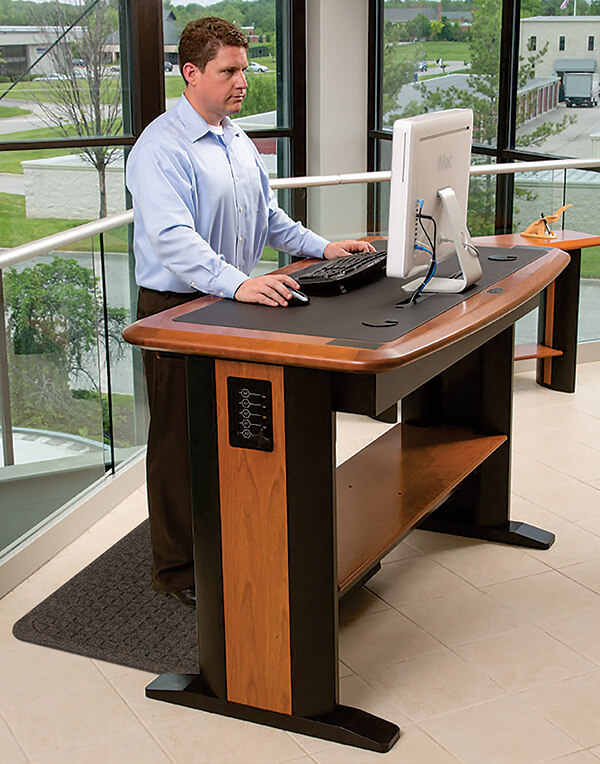
Do You Need a Mat for a Standing Desk?
More and more seated workers are turning to standing desks to break up their workdays, experience fewer aches and pains related to sitting all day, and gain increased focus and productivity. In addition to common, acute symptoms that seated workers experience like shoulder, neck, and lower back pain and soreness, and swelling in the lower extremities, more and more studies are showing that workers that sit all day are at higher risk for even more serious conditions. These conditions can range from increased risk of obesity, certain types of cancer, cardiovascular disease, type 2 diabetes, and others.
With such evidence that sitting all day is not working for our benefit, many workplaces and employees have ditched the traditional desk in favor of standing desks or even sit-stand desks that can be created through standing desk converters. Standing desks are pieces of ergonomically designed furniture that allows a seated worker to both sit in an office chair and stand while working, making it easier for them to transition back and forth and increasing their ability to move more during their long hours at the office. Of note when using these desks is the use of an accompanying anti-fatigue standing desk mat. You may wonder if you need a floor mat for a standing desk, and the answer is a resounding “yes.”
Before we look squarely at selecting an anti-fatigue standing mat to accompany a stand up desk, let’s take a deeper look into why a seated worker would want to switch to a standing position, how it can benefit them, and why you would need to use a comfort mat with a standing desk. Ultimate Mats is committed to getting cushioning anti-fatigue mats under the feet of the standing workforce, and we can help you find the perfect mat to accompany your standing desk.
What Are the Risks of Seated Work?
Sitting behind a computer all day seems pretty low-risk. Most of us, in fact, have been sitting behind a computer screen since we began working. This is a huge change that has just happened in the last forty to fifty years. In fact, in the 1960s, one out of every two Americans had a job that was considered very active. Today, the number of us that are even moderately active at work is less than 20%.
With the rise of computer usage and computer-based business, more and more of what we used to do in person is now done online or by some way of e-commerce. This increase has had a negative impact on our health, as aforementioned. In addition to issues like obesity, diabetes, and cardiovascular disease, minor concerns that can turn into long term issues plague seated workers. This is due in part to muscle rigidity.
When a seated worker sits in one position for long periods of time, the muscles become stiff and rigid. When the muscles become stiff and rigid, they tighten around surrounding blood vessels, causing them to constrict and decrease proper circulation. This results in aches, pains, and swelling. One of the best ways to alleviate this pain is by making sure the employee takes adequate breaks, moves around, and stays hydrated. In addition, using a standing desk can also help.
The risks for muscle rigidity, it should be noted, are not limited to seated workers. Standing workers experience these same symptoms if they stand in place for long periods of time without moving around enough. As such, both standing workers and seated workers can benefit from the increased movement throughout their day and anti-fatigue matting.
What are the Benefits of Using a Standing Desk?
With all these health risks, you can be sure we have taken notice. Now, there is a major fight to regain our health while maintaining our ability to get our seated work done. Enter ergonomics. Ergonomics is the study of how workers become more efficient when their workspaces are adapted to them, instead of them having to adapt to their workspaces. Having an ergonomic workspace is beneficial for the employer and the employee. Ergonomic workstations result in increased productivity and efficiency in the employee, reduce worker’s compensation claims, and seriously reduce risk of on the job injury.
One of the most beneficial pieces of ergonomic furniture available today is the standing desk. Standing desks have been available for several decades, however, they are now gaining increased popularity due to the aforementioned health concerns which are now more widely known and accepted. Here are some great benefits of using a standing desk in your workspace:
Decrease acute pain. Standing for your work for even half an hour every four hours you work can significantly decrease your back, neck, and shoulder pain. When the body is in an erect position, the posterior chain works to keep it aligned properly, unlike when you are in a seated position, where there is a higher likelihood you will slouch and experience pain. It can also help strengthen the leg muscles!
Lower your risk of obesity. Obviously standing will burn more calories than sitting. But standing for even a small portion of your day can make a huge difference in the number of calories you burn over an extended period of time. And since obesity can lead to things like heart disease and diabetes, this is something to be taken seriously! Even fifteen to thirty minutes of standing work can have an overall weight-loss impact if it is done on a daily, cumulative basis.
Improve energy and focus. Standing during parts of your day helps you regain focus and blood flow. Natural circadian rhythms tend to hit a lull between noon and 3:00 p.m. Standing for half an hour during this time can send the message to your brain that it’s still working time and it’s time to be alert and focused. This can improve overall energy levels and make you feel more refreshed if you are subject to the afternoon “slump.” Thus, this increases your efficiency and productivity, which will not only make you a happier employee, it will likely make you a highly favored one as well!
Why Do You Need a Mat for a Standing Desk?
If you’re definitely sold on a standing desk, you should know that using one without a standing desk anti-fatigue mat can be a huge mistake. As previously mentioned, standing employees are still at risk of developing some of the same health concerns as seated employees. The real issue with any type of work that keeps you in one position non-stop goes back to muscle rigidity. When those muscles become rigid and constrict the blood vessels, the pain starts, and the worker begins feeling sore, achy, and fatigued.
An anti-fatigue mat can be a godsend for workers that stand all the time on a hard floor or even on occasion. Anti-fatigue mats work by providing a cushy surface for a standing employee to place their feet upon while they are working. You may think that the real benefit is the cushioned surface, which provides a soft place for sore bare feet in contrast to the hard surface below. While the padded surface definitely helps workers feel less pain in their feet, ankles, and calves, the real benefit is a bit more scientific.
Anti-fatigue mats provide a surface that creates a slight instability under the feet of the standing worker, making them different from flat mats. This instability is not felt by the worker, so they never feel unbalanced, but the slight instability causes the muscles in the feet, ankles, and calves to constantly make micro-adjustments to keep balanced. Those tiny muscle movements prevent muscle rigidity, making the worker overall less fatigued, and preventing circulatory issues from occurring.
Additionally, anti-fatigue mats encourage employees who typically sit for their work to stand more. An employee is more likely to stand for their work if they know they can do so comfortably. Having a beveled edge, non-slip, high-density quality mat under their feet makes standing more comfortable and more inviting. A worker who would normally stay seated hour after hour will be more encouraged to break and stand for their work occasionally when they have an ergodriven comfortable mat upon which to stand.
Anti-fatigue standing desk mats have also been dubbed “get-fit” mats. This is because the standing employee generally burns more calories than a seated worker. As such, these mats have gained buzz-worthy popularity in the workforce as a great way to improve posture, burn more calories, and gain a higher level of fitness. Remember, a caloric burn is highly cumulative. In other words, you may not think that standing for half an hour a day is really going to make an impact on your weight. But if you burn an additional fifty calories by standing and you do this every day you work, the cumulative effect is inevitable weight loss.
Using an anti-fatigue mask under your standing desk is a must. A standing desk is a great way to keep your body moving and healthy while you do work that is normally designed to be done while seated. Standing improves overall health and helps diminish the risk of seated work-related pain and injury. Using an anti-fatigue mat keeps your muscles moving by creating a slightly unstable surface that causes your muscles to make micro-adjustments to stay balanced. This results in muscles that are less fatigued and a body that does not hurt or ache from being in one position for too long. Standing can also increase caloric burn, which is why anti-fatigue mats are often referred to as “get-fit” mats. Using an anti-fatigue mat with a standing desk is the most ergonomically effective way to perform standing desk work.
Sources:
https://www.ajpmonline.org/article/S0749-3797(10)00413-7/fulltext
https://www.healthline.com/health-news/how-your-job-might-be-making-you-fat
https://www.webmd.com/fitness-exercise/standing-desks-help-beat-inactivity
